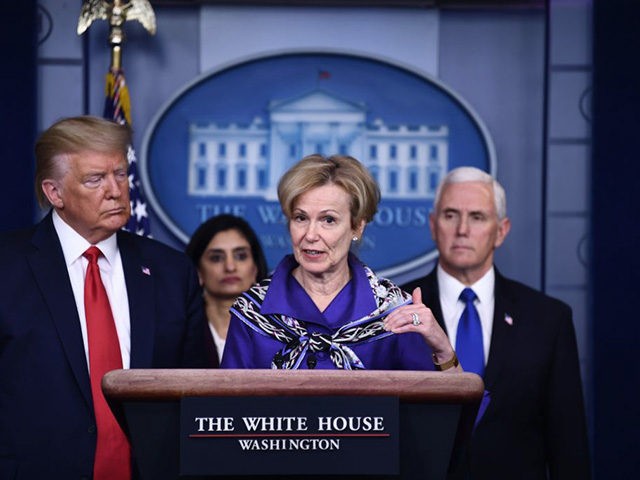The White House Coronavirus Task Force beginning on Wednesday will start receiving all data related to the virus directly from hospitals instead of using the Centers for Disease Control (CDC) as a clearinghouse between the front lines and the experts tasked with reporting to the American people about the disease.
The guidance is explained in a document Health and Human Services (HHS) posted online:
On March 29, 2020, Vice President Pence sent a letter to hospital administrators across the country requesting daily data reports on testing, capacity and utilization, and patient flows to facilitate the public health response to the 2019 Novel Coronavirus (COVID-19). Many separate governmental entities are requesting similar information, resulting in stakeholder requests to reduce duplication and minimize reporting burden. This document details the Federal Government’s data needs, explains the division of reporting responsibility between hospitals and states, and provides clear, flexible options for the timely delivery of this critical information. The objective is to allow states and hospitals either to leverage existing data reporting capabilities or, where those capabilities are insufficient, to provide guidance in how to build upon existing capabilities. These FAQs will be posted to the various HHS and HHS division websites, and will be as necessary.
It is critical to the COVID-19 response that all of the information listed below is provided on a daily basis to the Federal Government to facilitate planning, monitoring, and resource allocation during the COVID-19 Public Health Emergency (PHE). This data will be used to inform decisions at the federal level, such as allocation of supplies, treatments, and other resources.
But the New York Times painted the move as the Trump administration interfering with the CDC’s role of tracking infectious diseases and hampering those who depend on its data collection.
“Historically, CDC has been the place where public health data has been sent, and this raises questions about not just access for researchers but access for reporters, access for the public to try to better understand what is happening with the outbreak,” Jen Kates, the director of global health and H.I.V. policy with the nonpartisan Kaiser Family Foundation, said in the Times report.
“How will the data be protected?” Kates said. “Will there be transparency, will there be access, and what is the role of the CDC in understanding the data?”
The Times bemoaned the development:
News of the change came as a shock at the CDC, according to two officials who spoke on the condition of anonymity because they were not authorized to discuss the matter. Michael R. Caputo, a Health and Human Services spokesman, called the CDC’s system inadequate and said the two systems would be linked. The CDC would continue to make data public, he said.
“Today, the CDC still has at least a week lag in reporting hospital data,” Caputo said. “America requires it in real time. The new, faster and complete data system is what our nation needs to defeat the coronavirus, and the C.D.C., an operating division of H.H.S., will certainly participate in this streamlined all-of-government response. They will simply no longer control it.”
Public health experts have long expressed concerns that the Trump administration is politicizing science and undermining its health experts, in particular the CDC; four of the agency’s former directors, spanning both Republican and Democratic administrations, said as much in an opinion piece published Tuesday in the Washington Post. The data collection shift reinforced those fears.
“Centralizing control of all data under the umbrella of an inherently political apparatus is dangerous and breeds distrust,” Dr. Nicole Lurie, who served as assistant secretary for preparedness and response under former President Barack Obama said in the Times report. “It appears to cut off the ability of agencies like CDC to do its basic job.”
The Times said Deborah Birx, member of the task force and the White House coronavirus response coordinator, believed there were problems with how hospitals were reporting virus data and led a working group of government and hospital officials, which came up with the plan.
The new guidance also said hospitals who are reporting daily to state officials “could continue to do so if they received a written release saying the state would handle reporting.”
The Times found sources who favor the CDC over the task force for heading data collection, but its report also found that the CDC has been criticized for its data collection.
“In May, the agency acknowledged that in tracking the spread of the virus, it had been combining tests that detect active infection with those that detect recovery from Covid-19,” the Times reported. “That system muddied the picture of the pandemic but raised the percentage of Americans tested as President Trump was boasting about the number of tests the United States was conducting.”
And in Florida, the mayor of Miami-Dade County, Carlos A. Giménez, was so concerned about getting accurate data that he asked hospitals to provide data directly to him.
The Times also reported Arizona ended its partnership with a university modeling team after it showed a rising caseload, which caused pushback from Will Humble, the executive director of the Arizona Public Health Association and a former director of the state’s Health Services Department, to push back.
“Trust and accountability and transparency — all three go together,” Humble said.
Follow Penny Starr on Twitter

COMMENTS
Please let us know if you're having issues with commenting.